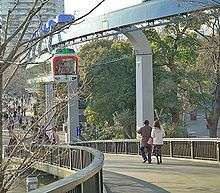Tokyo Metropolitan Bureau of Transportation
Tokyo Metropolitan Bureau of Transportation (東京都交通局 Tōkyō-to Kōtsū-kyoku), also known as Toei (都営),[Note 1] is a bureau of Tokyo Metropolitan Government which operates public transport services in Tokyo. Among its services, Toei Subway is one of two rapid transit systems which make up the Tokyo subway system, the other being Tokyo Metro.
Toei Subway
 | |||
| Overview | |||
|---|---|---|---|
| Native name |
都営地下鉄 Toei chikatetsu | ||
| Locale | Tokyo, Japan | ||
| Transit type | Rapid transit | ||
| Number of lines | 4[1] | ||
| Number of stations | 106[1] | ||
| Daily ridership | 2.85 million (FY2014)[1] | ||
| Website | Toei | ||
| Operation | |||
| Began operation | 1960 | ||
| Operator(s) | Tokyo Metropolitan Bureau of Transportation | ||
| Technical | |||
| System length | 109.0 km (67.7 mi)[1] | ||
| Track gauge |
1,435 mm (4 ft 8 1⁄2 in) 1,372 mm (4 ft 6 in) 1,067 mm (3 ft 6 in) | ||
| |||
The Toei Subway (都営地下鉄 Toei chikatetsu) lines were originally licensed to the Teito Rapid Transit Authority (the predecessor of Tokyo Metro) but were constructed by the Tokyo Metropolitan Government following transfers of the licenses for each line. The subway has run at a financial loss for most of its history due to high construction expenses, particularly for the Oedo Line. However, it reported its first net profit of ¥3.13bn in FY2006.
Tokyo Metro and Toei trains form completely separate networks. While users of prepaid rail passes can freely interchange between the two networks, regular ticket holders must purchase a second ticket, or a special transfer ticket, to change from a Toei line to a Tokyo Metro line and vice versa. The sole exceptions are on the segment of the Toei Mita Line between Meguro and Shirokane-Takanawa, where the platforms are shared with the Tokyo Metro Namboku Line, and at Kudanshita on the Shinjuku Line, where the platform is shared with the Tokyo Metro Hanzomon Line. At these stations, it is possible to change between the networks without passing through a ticket gate.
Lines
The Toei Subway is made up of four lines operating on 109.0 kilometers (67.7 mi) of route.[1]
| Line color | Mark | Line number | Line | Japanese | Route | Stations[1] | Length[1] | Opened | Gauge[1] | Current supply[1] |
|---|---|---|---|---|---|---|---|---|---|---|
| rose | Line 1 | Asakusa Line | 浅草線 | Nishi-Magome to Oshiage | 20 | 18.3 km | 1960 | 1,435 mm (4 ft 8 1⁄2 in) | 1500 VDC, overhead supply | |
| blue | Line 6 | Mita Line | 三田線 | Meguro to Nishi-Takashimadaira | 27 | 26.5 km | 1968 | 1,067 mm (3 ft 6 in) | ||
| leaf | Line 10 | Shinjuku Line | 新宿線 | Shinjuku to Moto-Yawata | 21 | 23.5 km | 1978 | 1,372 mm (4 ft 6 in) | ||
| ruby | Line 12 | Ōedo Line | 大江戸線 | Hikarigaoka to Tochōmae via Tochōmae, Roppongi and Ryogoku | 38 | 40.7 km | 1991 | 1,435 mm (4 ft 8 1⁄2 in) | ||
| Total | 106 | 109.0 km | ||||||||
Two of the lines have different colors for their station signs: Asakusa ("vermilion" A) and Shinjuku ("lime" S). The Ōedo line formerly had a darker "magenta" (O) as its designated color.
Through services to other lines
The different gauges of the Toei lines arose in part due to the need to accommodate through services with private suburban railway lines. Through services currently in regular operation include:
| Line | Through Lines |
|---|---|
| A Asakusa | KKKeikyu Kurihama Line and KKKeikyu Airport Line both via the KKKeikyu Main Line (Sengakuji to Haneda Airport Domestic Terminal (Tokyo International Airport) or Misakiguchi) |
| KSKeisei Oshiage Line, KSKeisei Main Line, KSNarita Sky Access Line, HSHokuso Line, KSKeisei Higashi-Narita Line and SRShibayama Railway Line (Oshiage to Narita Airport Terminal 1, Inba-Nihon-Idai or Shibayama-Chiyoda) | |
| I Mita | MGTokyu Meguro Line (Meguro to Hiyoshi) |
| S Shinjuku | KOKeio New Line and KOKeio Sagamihara Line both via the KOKeiō Line (Shinjuku to Hashimoto or Takaosanguchi) |
| E Ōedo | none |
- Mita Line shares tracks of the section from Meguro to Shirokane-Takanawa with Tokyo Metro Namboku Line, 2.3 km.
According to the company, an average of 2.34 million people used the company's four subway routes each day in 2008. The company made a profit of ¥12.2 billion in 2009.[2]
Stations
There are a total of 99 "unique" stations (i.e., counting stations served by multiple lines only once) on the Toei Subway network, or 106 total stations if each station on each line counts as one station.[1] Almost all stations are located within the 23 special wards, with many located in areas not served by the complementary Tokyo Metro network.
Rolling stock
Light rail lines

In addition to the subways, Toei also operates the Toden Arakawa Line streetcar, the Ueno Zoo Monorail, and the Nippori-Toneri Liner automated guideway transit.
Bus lines
Toei operates local bus service in central Tokyo, generally to fill in the gaps unserved by the Tokyo Metro and Toei Subway networks.
Most routes are designated by a kanji character followed by a two-digit route number. The initial character usually indicates the main railway station where the line terminates: for instance, 渋66 (Shibu 66) is a suburban route from Shibuya Station. Some routes replace the initial character with Latin letters, one prominent example being the RH01 service between Roppongi Hills and Shibuya. Others use a special character derived from the route, such as 虹01 (Niji [Rainbow] 01) which crosses the Rainbow Bridge. Some cross-town routes begin with the character 都 (to "metropolitan").
Other services
Tokyo Metropolitan Bureau of Transportation also maintains a large fiber optic cable network in the city, as well as several electric power generators.
History
Establishment
Tokyo City purchased the Tokyo Railway Company, a streetcar operator, in 1911, and placed its lines under the authority of the Tokyo Municipal Electric Bureau (東京市電気局 Tokyo-shi Denki Kyoku). The TMEB began bus service in 1924 as an emergency measure after the Great Kantō earthquake knocked out streetcar service in the city. (The TMEB was also responsible for providing electric power to Tokyo, but this service was privatized in 1942 as Tokyo Electric).
In 1942, the Japanese government forced a number of private transit businesses in Tokyo to merge into the TMEB. These included the bus lines of the Tokyo Underground Railway (whose Ginza Line remained independent), the Keio Electric Railway and the Tokyu Corporation, as well as the Oji Electric Tramway (operator of the Arakawa Line) and several smaller bus companies.
In 1943, Tokyo City was abolished and the TMEB's operations were transferred to the new TMBT.
Trolley buses
TMBT operated electric "trolley buses" between 1952 and 1968 on four routes:
- Route 101: Imai - Kameido - Oshiage - Asakusa - Ueno
- Route 102: Ikebukuro - Shibuya - Naka-meguro - Gotanda - Shinagawa
- Route 103: Ikebukuro - Oji - San'ya - Kameido
- Route 104: Ikebukuro - Oji - Asakusa
The trolley buses were short-lived, however, mostly owing to their vulnerability to weather: rain caused problems with the overhead power supply, and snow required tire chains to be installed on vehicles in order to maintain traction.
Notes
- ↑ Toei means "operated (ei) by the metropolitan government (to)."
References
- 1 2 3 4 5 6 7 8 9 10 東京都交通局ホーム - 経営情報 - 交通局の概要 - 都営地下鉄 [Tokyo Metropolitan Bureau of Transportation Home - Management Information - Overview of the Department of Transportation - Toei Subway] (in Japanese). 東京都交通局 [Tokyo Metropolitan Bureau of Transportation]. April 1, 2015. Retrieved 2016-01-17.
- ↑ Martin, Alex, "Ubiquitous Tokyo subways moving the daily masses", Japan Times, August 3, 2010, p. 3.
External links
| Wikimedia Commons has media related to Tokyo Metropolitan Bureau of Transportation. |
